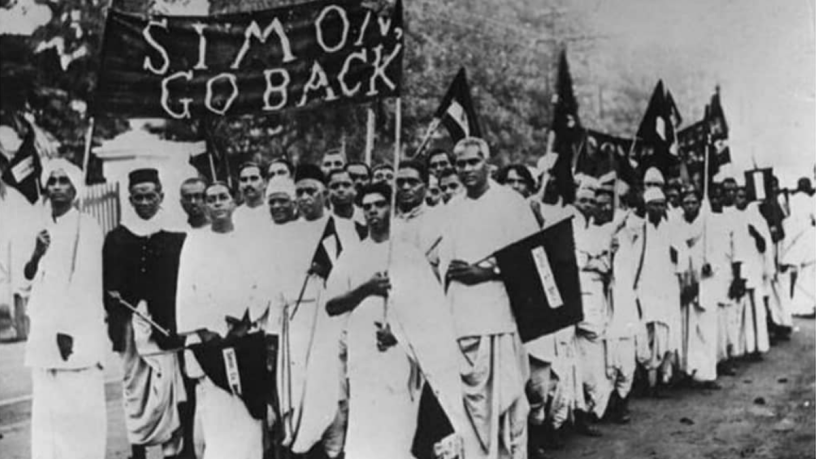Establishment of the Simon Commission: A Catalyst for Indian Resistance
History Indian HistoryPosted by NewAdmin on 2025-02-05 09:06:15 |
Share: Facebook | Twitter | Whatsapp | Linkedin Visits: 12

The Simon Commission was established in 1927 by the British government to review the working of the Government of India Act 1919 and to recommend future constitutional reforms. The commission was headed by Sir John Simon, a British Member of Parliament, and its primary objective was to evaluate the political and administrative situation in India and suggest changes to the system of governance. However, the Simon Commission quickly became a subject of intense controversy and opposition among Indians. The reason for this was that the commission consisted entirely of British members, with no Indian representation, despite the fact that the commission was supposed to assess the needs and aspirations of the Indian people.
The exclusion of Indians from the commission angered Indian leaders and the general public. It was seen as another example of the British government's disregard for the political rights of Indians and their desire for self-rule. The Indian National Congress, along with other political and social organizations, strongly protested the formation of the Simon Commission. A slogan, "Simon Go Back," became popular across the country, as it represented the widespread resentment toward the commission's lack of Indian representation.
The Simon Commission’s arrival in India in 1928 led to large-scale demonstrations and protests, particularly in cities like Lahore, where the protests turned violent. Lala Lajpat Rai, a prominent leader in the protest movement, led a demonstration in Lahore, where he was injured in a police baton charge. Despite his injuries, Lajpat Rai’s resistance became a symbol of the larger struggle against British colonial rule. Tragically, Lajpat Rai succumbed to his injuries later, which further fueled the nationalist sentiments in India. The death of Lajpat Rai was a catalyst for more radical actions by Indian leaders.
In response to the widespread discontent, the British government eventually agreed to hold discussions with Indian representatives to consider constitutional reforms. However, the Simon Commission itself failed to gain the trust or support of the Indian population, and its recommendations were largely dismissed. Despite its failure, the establishment of the Simon Commission played a key role in further galvanizing Indian nationalism and heightened the demand for full self-rule, leading to increased political activity in the years that followed. The incident also contributed to the growing realization that the British government’s policies would no longer be acceptable to the Indian people, accelerating the momentum toward independence.
Search
Categories
- Sports
- Business
- History
- Politics
- International
- Science & Technology
- Social Issues
- Disaster Management
- Current Affairs
- Education
- Startup Business
- Startup News
- Awards
- Community Services
- Fundraising Events
- Volunteer Services
- Health Initiatives
- Innovations and Initiatives
- In News
- dummybanners
- Awards
- Partners
- Products
- Press Releases
- News
- Fast Check
- South
- సినిమా
- Gallery
- Sunday Chronicle
- Hyderabad Chronicle
- లైఫ్ స్టైల్
- National
- క్రైం
- ట్రెండింగ్
- జాబ్స్
- అంతర్జాతీయo
- బిజినెస్
- రాజకీయం
- బిజినెస్
- సంపాదకీయం
- నవ్య
- చిత్ర జ్యోతి
- క్రీడలు
- జాతీయం
- తెలంగాణ
- తాజా వార్తలు
- మన పార్టీ
- మన నాయకత్వం
- మన విజయాలు
- డౌన్లోడ్స్
- మీడియా వనరులు
- కార్యకర్తలు
- North East Skill Center News
- Government Schemes
- Entrepreneurship Support
- Employment Opportunities
- Skill Training Programs
- Departments
- Investments
- Initiatives
- Resources
- Telangana IT Parks
- Events & Jobs
- Press Releases
- News
- Airport News
- Newtons Laws of Motion
- Karbonn in Business
- Investments in Karbonn
- Company quarterly sales
- Markets
- Auto News
- Industry
- Money
- Advertisements
- Stock target
- Company Updates
- Stock Market
- Company Sales
- Staffing and HR
- Constituency Assembly
- General News
- Srikalahasti Temple
- Bojjala Sudhir Reddy
- Technology & Innovation
- Sports
- Business
- Products
- Industries
- Services & Trainings
- Tools & Resources
- Technology Integration
- Drug Seizures & Arrests
- Telangana Narcotics
- Law & Enforcement
- Rehabilitation
- Nationwide Drug Policing
- Nigeria Seizures
- Global Operations
- Drug Awareness
- Drug Enforcement Tech
- NCB Drug Seizures
- Judicial Crackdown
- India's Surveillance Tools
- Cross-Border Links
- Women Safety
- Cyber Crimes
- Drug Abuse
- Traffic & Road Safety
- Community Connect
- Public Safety Alerts
- Citizen Assistance
- Nellore City News
- Politics & Administration
- Events & Festivals
- Agriculture & Rural
- Business & Economy
- Health & Wellness
Recent News
- Hurricane Erin Causes Beach Closures And Concerns For Coastal Communities
- Judge Frank Caprio Dies At 88, Shared Heartfelt Message Hours Before Passing
- Israel Strikes Hezbollah Targets In Southern Lebanon, Invokes 'Self-Defense'
- Mourners outraged by violent attack at funeral
- CM continues public hearings, says attack won't break her spirit
- Fix waterlogging in government-run schools: Minister urges officials for action
- Mourners condemn attacks at funeral of Brazilian councilwoman
- Philips i9000 Review: Premium shaving, reliable performance